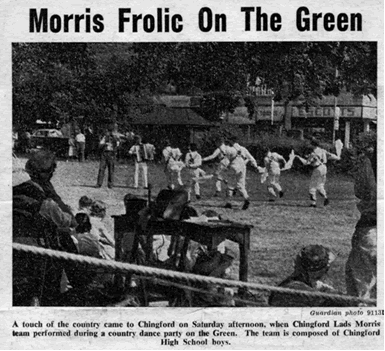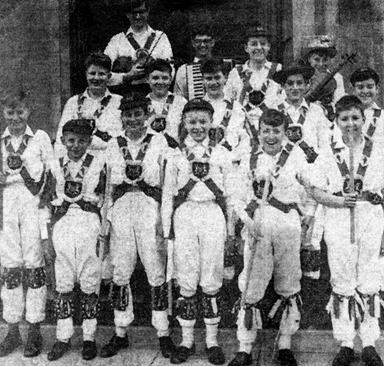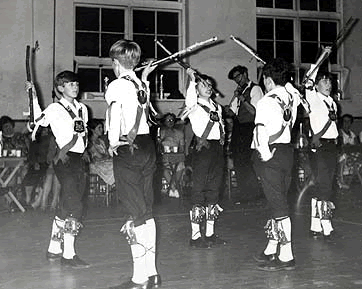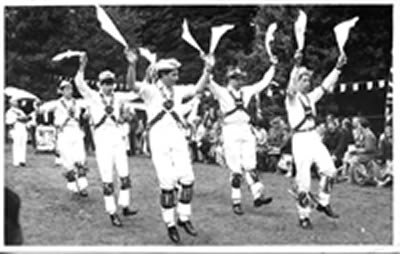
The foundation of Chingford Morris Men can be traced back to Peter Boyce’s arrival at Chingford County High School described on the Morris Dancing page of this site. The first session in the school gymnasium was packed out but over the next few weeks numbers fell as many boys decided that they didn’t like it or found it too difficult. However, after a few weeks a group of keen dancers was formed into the first school team. The team gave its first performance at the annual school fête on the sports field in July. Kit for this first performance was very make do and mend consisting of cricket whites, 2 school ties crossed over each shoulder to form a makeshift baldrick, school caps and a single leather strap around each calf with half a dozen Morris bells and white and blue braid to make simple bell pads. This first performance drew a lot of interest and one of the audience, himself a former Morris dancer with a team called London Rodney was soon in conversation with Peter Boyce, a meeting which later led to the formation of a men’s team (which included a couple of 6th formers), which met in the hall at Chingford Old Church. Other early performances included a spot during a country dance party on the Green.
 |
The accompanying article includes the following: Guest artists were the Chingford Lads Morris Team – a group of Chingford High School boys, most of whom learned the rudiments of Morris dancing at Chingford (C. of E) Primary School. Formed only 18 months ago the Team is coached by High School biology master Mr. P. R. Boyce, who led on a fiddle. |
|
Peter also entered 2 teams in the Walthamstow Festival of Music and Dancing. |
|
 |
|
Peter was very keen to instil his love of Morris and its traditions into the fledgling school team so when the team was quite new he organised a visit by the school teams from his previous school in Weston-super-Mare. The event was great success with performances in the school hall and a Morris “Feast” in the dining hall. By this time we had proper baldricks consisting of red braid with a school blazer badge at the cross over on the front. The Weston school had 2 teams, one the same age as the Chingford team and one consisting of 6th formers who performed a stick dance that was to have a major impact on the Chingford school team and also the later Chingford Morris Men.
The dance was one that Peter had developed from a fragment of the traditional Upton upon Severn stick dance. It was quite different from any dance the team had previously learnt. As foreman of the team, I asked Peter to teach it to us, added a new figure and the dance became the team’s trademark. I went on to create a number of dances in the same style, which became the Chingford “tradition” and they now form the exclusive repertoire of the Chingford Morris Men, something I’d always hoped for but which only actually happened after I’d moved away from Chingford. (You can read a full account of the development of the Chingford stick dance and the other dances in the Chingford "tradition" here. )
Peter also brought in other experienced dancers to teach the team including Hugh Rippon the founder of Hammersmith Morris Men who at that time worked for the English Folk Dance and Song Society. Later on he also asked Brian Hayden to teach both rapper sword and clog dancing. Peter had taught the published Newbiggin rapper sword dance but invited Brian to teach the dance from Amble, which, as a member of the Newcastle Kingsmen he had been involved in collecting from the traditional team a few years previously and had yet to be published. Brian had also been a pupil of the renowned clog dancer Johnson Ellwood and when Peter had exhausted his own repertoire of two clog dance steps and a break which he’d learnt at a folk weekend in Derbyshire he got Brian to teach the interested members of the team several more steps and breaks.
Some of the ex-Kings Road pupils had been asked by Mrs Murray to help teach another group of boys at the primary school and so when they came to CCHS a younger school team was formed. By this time the older team members were also dancing with Chingford Morris Men and so the younger team took over the name “Chingford Lads”, the name by which the original school team had been known. Like the original team the members weren’t exclusively from Kings Road.

The boys in the Lads also learnt the same extensive repertoire of dances including clog dancing and rapper sword.
The Lads team were invited to appear on Blue Peter to perform a Morris dance accompanied on concertina by John Watcham and also a rapper sword dance. The BBC sent a minibus to transport them to the studio. When the minibus reached Hanger Lane on the North Circular Peter suddenly jumped up and said “I’ve forgotten the swords!” He caught the tube, made his way back to school to pick up the set of swords and arrived at the studios clutching the swords in time for the final rehearsal before the broadcast with Val Singleton, Peter Purves and John Noakes.
Both teams performed at the annual Folk Festival at the Royal Albert Hall. In their early days, the original school team were asked to appear in the matinee performances and also appeared in later years as members of Chingford Morris Men. The festival was produced by Ron Smedley, a BBC TV producer (and Morris dancer) and he was also responsible for putting on performances at other festivals and he involved the younger Lads team in many of them. Peter put on a performance for parents which showcased the teams’ many varied talents by taking a tour of British customs through the year. It included Morris, sword, clog dancing, singing, the Padstow May Day Hobby Horse, a mummers play and other traditions.
 |
| Early Chingford with Paul Wilson (nearest camera) and me (behind Paul) from the school team and wearing the school kit, and Peter Boyce (2nd right) and others from the men's team. The musician is the Rev Kenneth Loveless who became an honorary member of the team |
By now the older team were all in the sixth form and formed the backbone of Chingford Morris Men as well as dancing as a school team.
One summer they spent two and a half weeks on tour in the West Country performing in Corfe Castle, Swanage and Weymouth before spending a week at a folk camp near Lynmouth and finally appearing for the first time at Sidmouth Folk Festival. The Sidmouth Festival was to become a regular event over the years for both school teams (and later Chingford Morris Men after everyone had left school) and on one memorable occasion we were honoured to be asked to provide the final arena performance of the week before a crowd of approx. 7000 people.
I was Foreman of Chingford for several years until I married and moved to Lancashire but I’m pleased to say that the team celebrated its 50th anniversary in 2012 and is still going strong. Their website can be found at http://filk.co.uk/chingford/
